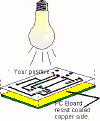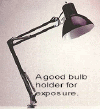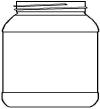PRINTED CIRCUIT BOARD
instructions for using
PREMIER POSITIVE-acting Boards.
(LINK
for Negative Instructions)
(LINK for "how to make 2-sided boards)
Link to Premier Boards Catalog Page
(Copyright LKG Industries
2003)
INSTRUCTIONS for USING the DATAK PREMIER
series
POSITIVE ACTING PRINTED CIRCUIT BOARDS.
note that small photos may be "clicked"
for large view
Premier Positive boards have a dielectric constant of 3.6 (at) 1 MHz.
POSITIVE PRESENSITIZED PC BOARDS
The Method is the easiest to use of the various
methods for making a PCB. Although the negative method may cost less, the
Positive method’s fewer steps and time savings more or less offset any
savings in material costs.
Positive PC Boards… What are they? The boards are
standard, 1 oz. copper PC boards with a Fiberglas substrate. The copper is
coated with a light-sensitive chemical that is often called a
photo-resist or a sensitizer. When this coating is
exposed to enough light, the coating will rinse away in a developer
solution, exposing the copper beneath. The copper is then etched, leaving
untouched the copper pads and traces that are your circuit.
Positive boards are available in a number of sizes
ranging from 2″ x 4″ up to 12″ X 12″ and with the photo resist, or
sensitizer and copper on one or two sides.
Before use, you may want to cut the PC
board to size. The ideal cutting tool is a sheet metal shear. Please be
careful if using a paper cutter as there is a different pull and ‘feel’
when cutting a board and fingers could be “dragged” into the blade and
severely injured if you do not hold the board very, very securely.
Be sure to Score the
protective film with a sharp knife on the line where you will be shearing
the PC board. Or, score it with a cut on either side of the line where it
will be sheared. Scoring the protective plastic film will prevent the
plastic from pulling resist from adjacent areas during the shearing. (Use
an Xacto, or other very sharp knife for scoring.)
NEW and big savings…
this is a fairly new and excellent enhancement for positive boards. An
Ultraviolet, or U/V, light source is not needed for exposing the Premier
Series PC boards. And note that if you were accustomed to using our older
systems, you will now mix the developer concentrate ten to one with
tap water instead of the older recipe of three to one.
EXPOSURE
and DEVELOPING:
Step 1. Work in very subdued light with
no sunlight or fluorescent light entering the room. A yellow 25 watt
‘bug light” bulb provides a good safelight; or use a low wattage (15W)
incandescent bulb at a distance from the PC Board.
Cut the PC board to size
and then remove the plastic protective cover from the PC board with a
peeling motion, rolling it back off of the resist. Roll the cover slowly,
with a steady pressure. Pulling ‘up’ on the film may remove some resist
from the PC board.
Place the board, resist side up
in a Datak exposure frame or under a heavy piece of glass. Place your
positive on top of the sensitized coating on the PC board and sandwich the
two in the exposure frame.
The Exposure Frame: This device will be familiar to you if you have ever
made photographic prints. The frame is simply a holder for a board and
piece of glass. With your positive in place on top of a precoated board,
put the two in the frame under the glass and slide into the frame. The
frame will hold the PC board and your positive tightly together during
exposure.
Expose
the PC board
Expose the
board, held in the frame, to the light of a 100 watt white light bulb. Best
results will result if the bulb is in a hooded, reflector type lamp shade.
By this, we mean the kind that is white inside and reflects light.
EXPOSURE TIMES: A
single 100 watt bulb at a distance of 12″ for a ten minute exposure time
is recommended for boards up to about 6″ X 6″ (or smaller) in size. We
suggest using a fairly “young” bulb, one with less than ten hours of use.
Exposure for PC boards
larger than 6″ X 6″ may require either using two bulbs, side by side
(about 2″ between them). Very large boards, about 12″ X 12″ can be done
either by exposing the two halves of the board separately or placing three
bulbs in a triangular pattern (which can be a bit tricky). You may cover
half a board with cardboard, expose for ten minutes and then expose the
other half while covering the exposed half.
Another
technique for exposing larger boards is to suspend the bulb from its power
cord and let it swing in a circle for roughly fourteen or fifteen minutes
(at the 12″ distance).
Develop the board:
While the board
is being exposed, prepare a tray of developer solution. Use either
Datak no. 12-402 or 12-406 liquid concentrate only. Mix the Datak
developer 1 part of concentrate to 10* parts water. NOTE: mix with warm
water. A cold developer is not going to work. The temperature should be
above room temperature (about 100 to 110 degrees F)
Use glass or a plastic photographic tray (never metal).
Use just enough developer to cover the board (1/4″ to 3/8″ deep is usually
good). After exposing, place the PC board in the tray and rock the tray
gently until the copper is fully exposed in areas to be etched. It will be
obvious to you when the copper is bare; be sure that there is no haze or
film remaining. Rinse a developed board in cold water for a minute. Tap
water is fine. Cold water stops the process and ‘sets’ the resist;
after immersion in clean cold water, normal room lighting will not affect
the resist further.
Etching the PC Board:
Your are now ready to etch the board. We suggest using
Datak Ferric Chloride etchant. It is messy and we warn against using this
etchant in a home environment (except out of doors) as it can stain almost
anything, including counter tops, floors etc.. Ferric Chloride is not an
acid, not especially dangerous in small amounts and is actually used in
some garden fertilizers. We DO recommend using goggles to
protect your eyes from splashes. And use with good ventilation; some
people find the fumes very irritating to the throat and lungs. This author
steps into the garden to etch boards; the plants do not seem affected at
all.
Disposal of expired
etchant can be done simply by flushing down a drain with a couple of
minutes of cold running water. Local Laws may require other disposal
methods so please check for your location.
Use Datak bottled Ferric
Chloride etchant or Datak powdered concentrate, which is then mixed with
water following the instructions on the package. Warm the etchant before
use. (You can warm the etchant by placing its storage bottle in a bucket
of hot tap water for about fifteen minutes.) Hot etchant works best, but
warm will work. Cold etchant may not get the job
done.
You can use the
etchant in a couple of ways. One, place the etchant in your photographic
tray and not too deep (never a metal tray; use glass or plastic). Place the
board, face up, in the etchant and then agitate the tray almost
constantly, including some rocking. It is important to keep the etchant
moving on the surface of the copper. Check periodically to see if the
etching is complete; be sure to etch all exposed copper. Time varies, but
you should be close to finished in not more than fifteen minutes.
This author prefers using a large mouth plastic jar
for etching. Placing about 3/8″ to 5/8″ deep etchant in the jar with your
PC board and placing the lid on the jar. This permits swirling and some
gentle shaking back and forth which will etch a board very quickly. A left
over jar from many foods from Cashews to Biscotti have a large enough
mouth and a plastic lid (never use a metal lid).
Monitor the etching progress by tipping the jar to see if copper has been completely removed from areas not protected by the resist. DO NOT over-etch; undercutting will occur and narrow traces and pad diameters. We expect small 2″ x 4″ boards and smaller to be finished in around seven minutes. The time required to etch is affected by the warmth of the etchant (warmer the better), the amount of swirling action, oxygen that gets into the solution while swirling and, of course, if the etchant is new or has been used before.
When ETCHING IS COMPLETE, you may rinse the board in a flush of tap water, dry with paper towels and proceed to drilling the pads. When you wish to remove the remaining resist, use a fingernail polish remover. Inspect the copper during drilling. (If there any breaks in lands (traces) or pads, you can bridge them with a small copper wire and solder.)
Final notes: Here are some helpful tips for
users of the positive PC boards:
1. Store used
developer in a plastic or glass bottle. Plastic is best as you may squeeze
most of the air out of the bottle and cap tightly. Do this because the
developer will react, over time, with the carbon dioxide in the air and
decompose.
2. You can use the developer until it
simply does not perform; then flush it down the sink with a fast cold
water chaser. Storing developer in a refrigerator can help to keep it
fresh for very long periods.
3. If the board
proves to be tough to etch, you probably did not develop it long enough
and some resist residue remained behind. Or, said residue can also be
caused by too short an exposure time, too weak a light source and so
on.
4. Etchant may be reused and stored in a plastic or
glass bottle; use only a plastic (not metal) cap.
When etchant is
obviously taking much too long to etch, it has expired and a fresh batch
is needed.
5. We strongly recommend that all PC board
drilling be done with a drill press. Accurate drilling with a handheld
drill is nearly impossible.
Questions? Ask us at
TheseusRob at Compuserve.com
or
request written instructions via Uncle Sam’s mail Be sure to send your
address in your request. Your email address will not be sold to anyone
else, but we may bother you with new product announcements once in a while.
end positive instructions. . (Copyright LKG Industries 2003) Link to Premier Boards Catalog Page




